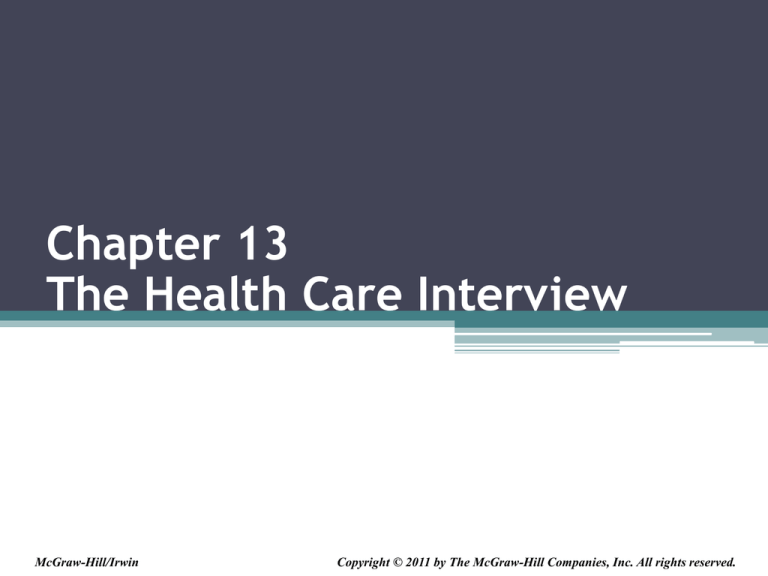
Chapter 13
The Health Care Interview
McGraw-Hill/Irwin
Copyright © 2011 by The McGraw-Hill Companies, Inc. All rights reserved.
13-2
Chapter Summary
•
•
•
•
•
•
•
Creating a Collaborative Relationship
Opening the Interview
Getting Information
Giving Information
Counseling and Persuading
Closing the Interview
Summary
13-3
Creating a Collaborative Relationship
• Sharing Control
▫ Both parties must share control
▫ Patients must be active and responsive
▫ It takes two to form an effective relationship
13-4
Creating a Collaborative Relationship
• Reducing Relational Distance
▫
▫
▫
▫
▫
▫
▫
Dwell on similarities, not differences.
Enhance relationships through understanding.
Be relaxed and confident.
Show interest in the “individual.”
Maintain objectivity.
Be sincere and honest.
Maintain appropriate control during the
interaction.
13-5
Creating a Collaborative Relationship
• Appreciating Diversity
▫ Gender influences communication and treatment.
▫ Culture
Health communication differs in the global village
▫ Be aware of how different people perceive roles
and purposes in health care interviews.
13-6
Creating a Collaborative Relationship
• Stereotypes
▫ Health care providers often stereotype patients.
▫ Stereotypes determine attitudes, and attitudes
may determine care, treatment, and satisfaction.
▫ So-called Good patients tend to get better
treatment than bad patients.
13-7
Creating a Collaborative Relationship
• Creating and Maintaining Trust
▫ Confidentiality and trust go hand-in-hand.
▫ Providers and patients cocreate trust.
13-8
Opening the Interview
• Enhancing the Climate
▫ The opening sets the tone for the entire interview
▫ Location and setting promote collaborative
interactions.
13-9
Opening the Interview
• Being Sensitive and Personal
▫ Use the opening to reduce apprehension
▫ Neither rush nor drag out the opening
▫ Politeness breeds politeness
13-10
Opening the Interview
• Adapting the Opening
▫ The opening must fit the situation
▫ Get the whole story
▫ Orient the patient
13-11
Getting Information
• Barriers to Getting Information
▫ Do not assume patients will provide accurate
information.
▫ Ask obviously relevant questions as soon as
possible.
▫ Weigh the ability of patients to respond.
▫ Provider dominance deadens interactions.
▫ Explain medical terms and procedures.
▫ Ask focused, explicit questions.
13-12
Getting Information
• Ways to Improve Getting Information
▫ Encourage turn-taking
▫ Asking and Answering Questions
The funnel sequence gives a sense of sharing control
Vary listening approaches
Continued…
13-13
Getting Information
• Ways to Improve Getting Information
▫ Telling stories
Encourage storytelling and listen
The less you talk, the more you say
▫ Listening, Observing, and Talking
Be patient and persistent
Use leading questions with caution
▫ Ineffective Methods
Single-Medium Messages
Information Overload
13-14
Getting Information
• Addressing the Language Barrier
▫ Communication breakdowns are the most
common root cause of health errors that harm
patients
▫ Successful programs have included
comprehensive interpreter services
13-15
Giving Information
• Causes for Loss and Distortion of Information
▫ Attitudes of Providers
▫ Problems with Patients
▫ Ineffective Methods
13-16
Giving Information
• Giving information more effectively
▫
▫
▫
▫
Give information that seems authentic.
Encourage patients to ask questions.
Do not overload patients with information.
Organize items of information systematically so
that they are easy to recall.
▫ Practice good communication skills.
▫ Use a variety of media to present information.
▫ Include a number of sources in the process.
Continued...
13-17
Counseling and Persuading
• Barriers to Effective Counseling and Persuading
▫ Watch for hints and clues about concerns about
real problems.
▫ Providers my try to dodge unpleasant exchanges.
▫ Know yourself to understand others.
13-18
Counseling and Persuading
• Effective Counseling and Persuading
▫ Five Critical Relational Factors
Empathy
Trust
Honesty
Mutual Respect
Caring
Continued…
13-19
Counseling and Persuading
• Effective Counseling and Persuading
▫
▫
▫
▫
Selecting an appropriate interview approach.
Providing an appropriate climate.
Encouraging interaction.
Considering solutions.
13-20
Closing the Interview
• The closing must be a collaborative effort
• Important questions and revelations occur
during the closing
13-21
Summary
• The health care interview is common, difficult and
complex.
• Situations vary from routine to life threatening.
• A collaborative and productive relationship will
reduce the anxiety, fear, hostility, and reticence that
often accompanies health care interviews.
• The provider and consumer must realize that good
communication is essential for effective health care
interviews.
• Skills require thorough training and practice.








